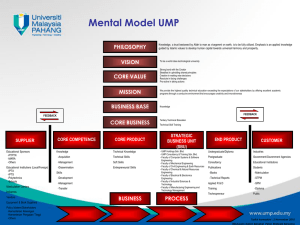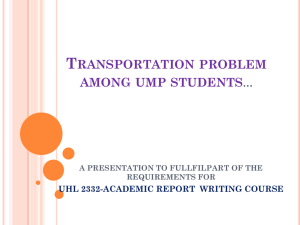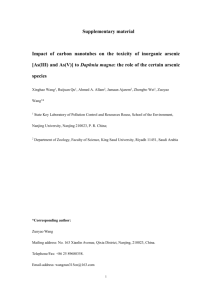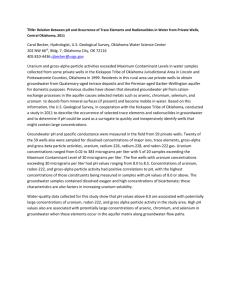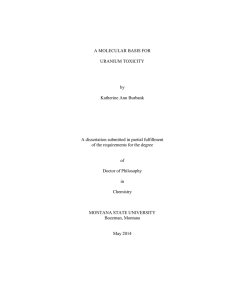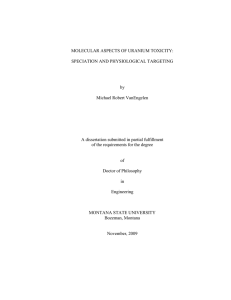wrcr20731-sup-0001-suppinfotext01
advertisement
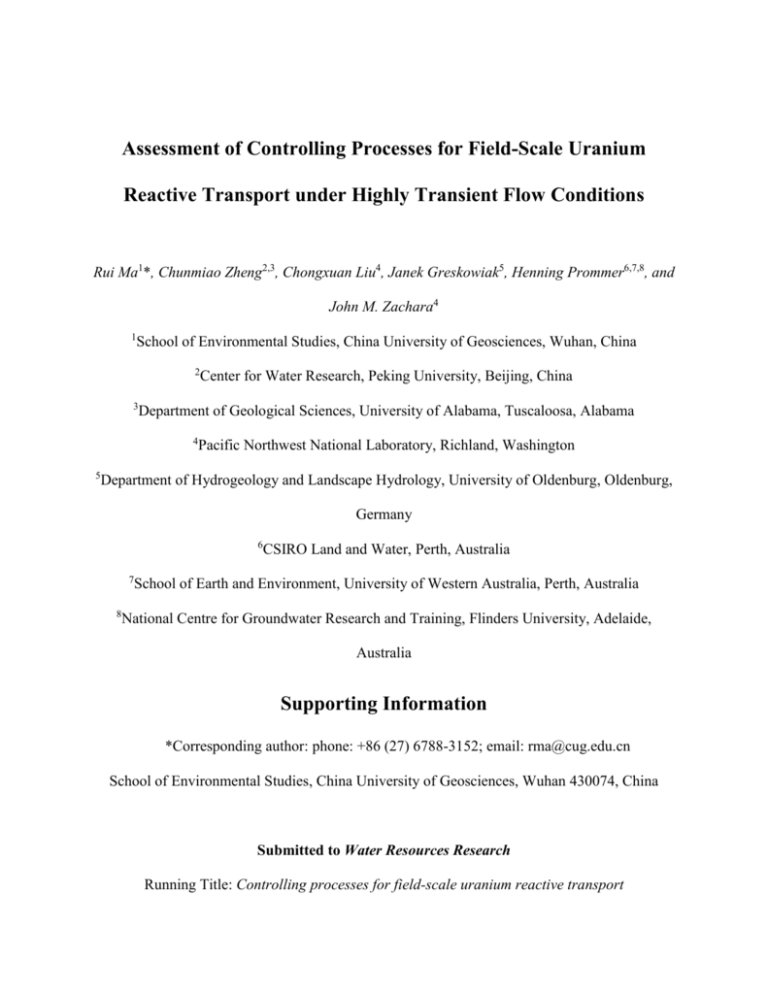
Assessment of Controlling Processes for Field-Scale Uranium Reactive Transport under Highly Transient Flow Conditions Rui Ma1*, Chunmiao Zheng2,3, Chongxuan Liu4, Janek Greskowiak5, Henning Prommer6,7,8, and John M. Zachara4 1 School of Environmental Studies, China University of Geosciences, Wuhan, China 2 3 Department of Geological Sciences, University of Alabama, Tuscaloosa, Alabama 4 5 Center for Water Research, Peking University, Beijing, China Pacific Northwest National Laboratory, Richland, Washington Department of Hydrogeology and Landscape Hydrology, University of Oldenburg, Oldenburg, Germany 6 7 8 CSIRO Land and Water, Perth, Australia School of Earth and Environment, University of Western Australia, Perth, Australia National Centre for Groundwater Research and Training, Flinders University, Adelaide, Australia Supporting Information *Corresponding author: phone: +86 (27) 6788-3152; email: rma@cug.edu.cn School of Environmental Studies, China University of Geosciences, Wuhan 430074, China Submitted to Water Resources Research Running Title: Controlling processes for field-scale uranium reactive transport Dual domain model: Liu et al. [2008] indicated that the dual domain multi-rate surface complexation model could better simulate the kinetic uranium reaction in the field-textured column with the sediment collected from Hanford 300A site. In their study, the multi-rate surface complexation model was coupled to a dual domain model to account for the impact of sub-facies scale physical and chemical heterogeneity in field-textured sediment columns on the U(VI) transport: Mj NS q kj ,m Cim 2 Ci Ci m m aij mv im (Cim Ciim ) m D 2 t t x x j 1 k 1 q kj ,m t kj (Q mj q kj ,m ) Mj q kj ,im Ciim N S m im aij (Ci Ci ) t j 1 k 1 t q kj ,im t k ,im kj (Q im ) j qj (S1) (S2) (S3) (S4) with i=1, 2, .., N; j=1, 2, ...Ns; k=1, 2, .., Mj whereby C im and C iim are the total aqueous concentrations of chemical component i in the mobile aqueous phase characterized by mobile porosity m , and in the immobile aqueous phase characterized by immobile porosity im , respectively. In the following discussion, the mobile and immobile aqueous phases are referred to as mobile and immobile domains. Symbols q kj ,m and q kj ,im are the concentrations of adsorbed species j at sorption domain k in the mobile and immobile domains, respectively; Q mj and Q im j are the sorption extents of adsorbed species j in the mobile and immobile domains, respectively, and are defined as the theoretical concentration of adsorbed species j that would be in equilibrium with the aqueous phase compositions; is the physical mass transfer coefficient between the mobile and immobile domains; N is the total number of chemical components. Transient flow conditions: The hydrographs for the wells within and near the IFRC site and stage for the Columbia River were given in Fig. S2(a).Groundwater levels in the wells instrumented within Hanford aquifer responded rapidly to the fluctuations of the Columbia River stage. This caused the dynamic change of groundwater flow directions and the magnitudes of hydraulic gradients determined using the classic three-point approach (Silliman and Frost, 1998) over the duration of the injection experiment as shown in Fig. S2(b). The change of Br and U(VI) concentration distributions during the experiment: There were only three cluster wells instrumented at the study site and most of the Br and U(VI) concentrations were measured from fully-screened wells. Thus, the 3D images of Br and U(VI) concentrations cannot be developed. The change of Br and U(VI) concentration distributions during the experiment were shown in Fig. S3. There are many uranium concentration spots observed due to the intraborehole flow effect. Mass centers of injected Br and U(VI) plumes as defined by Br and U(VI) concentrations transported through the central area of the well field as shown in Fig. S3. The change of cation concentrations in the models with and without considering cation exchange reactions: The main chemical difference between the injection and background water was that Na+ concentration in the injection water was one order of magnitude higher than that in the background water (Table 1). In the model without considering cation exchange reactions, the arrival times and peak concentration durations of injected higher Na+ breakthrough curves were similar to those of Br- and U(VI) breakthrough curves, while Ca2+, Mg2+ and K+ concentrations varied little during the test since their concentrations in the injected and background waters were close (Fig. S4). However, when considered cation exchange, the Ca2+ and Mg2+ concentrations in the model increased at the early period when injected higher Br and lower U(VI) concentration plumes arrived, and the injected higher Na+ concentrations arrived later than that in the model without considering cation exchange reactions (Fig. S5). This was caused by the exchange of aqueous Na+ with adsorbed Ca2+ and Mg2+. During the later experiment period, the Ca2+ and Mg2+ concentrations began to decrease to the level in the background water , meanwhile the Na+ concentrations started to increase with the peak concentration being lower than that in the model without considering cation exchange reactions. This indicated that the aqueous Ca2+ and Mg2+ exchanged with adsorbed Na+ . Compared Fig. S4 to Fig. S5, it can be seen that the cation exchange reactions affected the Ca2+, Mg2+ and Na+ concentrations. References: 1. Liu, C., S. Shi, and J. M. Zachara (2009), Kinetics of uranium(VI) desorption from contaminated sediments: effect of geochemical conditions and model evaluation, Environ. Sci. Technol., 43(17), 6560–6566. 2. Liu, C., J. M. Zachara, N. P. Qafoku, and Z. Wang (2008), Scale-dependent desorption of uranium from contaminated subsurface sediments, Water Resour. Res., 44, W08413, doi: 10.1029/2007WR006478. 3. Dong, W., and S. C. Brooks (2006), Determination of the formation constants of ternary complexes of uranyl and carbonate with alkaline earth metal (Mg2+, Ca2+, Sr2+, and Ba2+) using anion exchange method, Environ. Sci. Technol., 40, 4689–4695. 4. Guillaumont, R., T. Fanghänel, J. Fuger, I. Grenthe, V. Neck, D. Palmer, and M. H. Rand (2003), Update on the Chemical Thermodynamics of Uranium, Neptonium, Plutonium, Americium and Technetium, Elsevier: Amsterdam. 5. Hanford IFRC team (2010). Multi-Scale Mass Transfer Processes Controlling Natural Attenuation and Engineered Remediation: An IFRC Focused on Hanford's 300 Area Uranium Plume, Annual report to the DOE Office of Sciences, Pacific Northwest National Laboratory, Richland, Wash. 6. Silliman, S.E., Frost, C., 1998. Monitoring hydraulic gradient using three-point estimator. J. Environ. Eng. 124, 517–523. Table S1. U(VI) aqueous speciation reactions used in the reactive transport models (from Liu et al., 2008). Speciation reaction UO22+ + H2O = UO2OH+ + H+ UO22+ + 2H2O = UO2(OH)2(aq) + 2H+ UO22+ + 3H2O = UO2(OH)3- + 3H+ UO22+ + 4H2O = UO2(OH)42- + 4H+ 2UO22+ + H2O = (UO2)2(OH)3+ + H+ 2UO22+ + 2H2O = (UO2)2(OH)22+ + 2H+ 3UO22+ + 4H2O = (UO2)3(OH)42+ + 4H+ 3UO22+ + 5H2O = (UO2)3(OH)5+ + 5H+ 3UO22+ + 7H2O = (UO2)3(OH)7- + 7H+ 4UO22+ + 7H2O = (UO2)4(OH)7+ + 7H+ UO22+ + CO32- = UO2CO3(aq) UO22+ + 2CO32- = UO2(CO3)22UO22+ + 3CO32- = UO2(CO3)343UO22+ + 6CO32- = (UO2)3(CO3)662UO22+ + CO32- + 3H2O = (UO2)2(CO3)(OH)3- + 3H+ 3UO22+ + CO32-+ 3H2O = (UO2)3O(OH)2(HCO3)+ + 3H+ 11UO22+ + 6CO32- + 12H2O = (UO2)11(CO3)6(OH)122- + 12H+ 2Ca2+ + UO22+ + 3CO32- = Ca2UO2(CO3)3 Ca2+ + UO22+ + 3CO32- = CaUO2(CO3)32Mg2 ++ UO22++ 3CO32- = MgUO2(CO3)32UO22+ + NO3- = UO2NO3+ a Log K (I=0) -5.25 -12.15 -20.25 -32.40 -2.70 -5.62 -11.90 -15.55 -32.20 -21.90 9.94 16.61 21.84 54 -0.855 0.655 36.43 30.70 27.18 26.11 0.30 Guillaumount et al. (2003) Dong and Brooks (2006) b Table S2. Ion exchange reactions used in modeling (from Liu et al., 2009) Ion exchange reactions Log K Ca2+ + 2NaX = CaX2 + 2Na+ 1.88 Source a a a a a a a a a a a a a a a a a b b b a Mg2+ + 2NaX = MgX2 + 2Na+ 1.87 K+ + NaX = KX + Na+ 1.32 H+ + NaX = HX + Na+ 0.0 Fig. S1. Plan view of the Hanford IFRC site showing the model domain as a rectangle in green color (a) and IFRC experimental well field (b) (cited from Ma et al., 2011). Fig. S2. (a) River stage fluctuations and well hydrographs; (b) Groundwater flow direction and magnitude of hydraulic gradient calculated with three point method (Silliman and Frost, 1998) at the IFRC site during the experiment. Fig. S3. The U(VI) and Br concentration contours during the test Fig. S4. The breakthrough curves of simulated Ca2+, Na+, Mg2+ and K+ concentrations during uranium tracer test in the model without considering cation exchange reactions. Fig. S5. The breakthrough curves of simulated Ca2+, Na+, Mg2+ and K+ concentrations during uranium tracer test in the model with considering cation exchange reactions.
